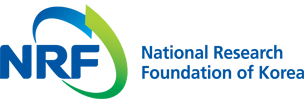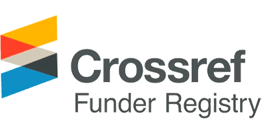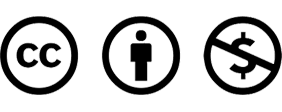-
Plant & Forest
- Impact of varied concentrations of fertilizer solution on the growth of red pepper plug seedlings
- In Sook Park, Myong Sun Park, Jong Myung Choi, Jong Pil Chun
- Objective of this research was to determine the optimal concentration of post-planting fertilizers (CPPFs) for raising the seedlings of three red-pepper varieties …
- Objective of this research was to determine the optimal concentration of post-planting fertilizers (CPPFs) for raising the seedlings of three red-pepper varieties using root media with an electrical conductivity (EC) of 0.3 dS·m-1 or less. The 72-cell plug trays were filled with root media and seeds were sown. Fertilization began 11 days after sowing with four treatment solutions such as 50, 100, 150, and 200 mg·L-1 based on nitrogen (N) concentrations and growth was investigated 39 and 56 days after sowing. As the CPPFs was elevated, all growth parameters of the three varieties significantly increased. The leaf areas in the second investigation were not different among varieties in all treatment solutions except 50 mg·L-1 and those increased by more than twice compared to the first investigation. The ‘AT Sinhotan’ pepper had a wider leaf area than other varieties. In the treatments with CPPFs of 150 mg·L-1 or higher at 56 days after sowing, a greater number of flower buds and bloomed flowers were observed, but only flower buds were observed in the treatments with CPPFs of 100 mg·L-1 or lower. In addition, the tissue content of inorganic elements including total nitrogen tended to increase as the CPPFs was elevated. The above results indicate that the optimum CPPFs is 150 mg·L-1 or higher when hot pepper seedlings are raising in root media with EC of 0.3 dS·m-1 or lower. The elevated fertilizer concentrations would increase seedling quality and shorten the raising duration. - COLLAPSE
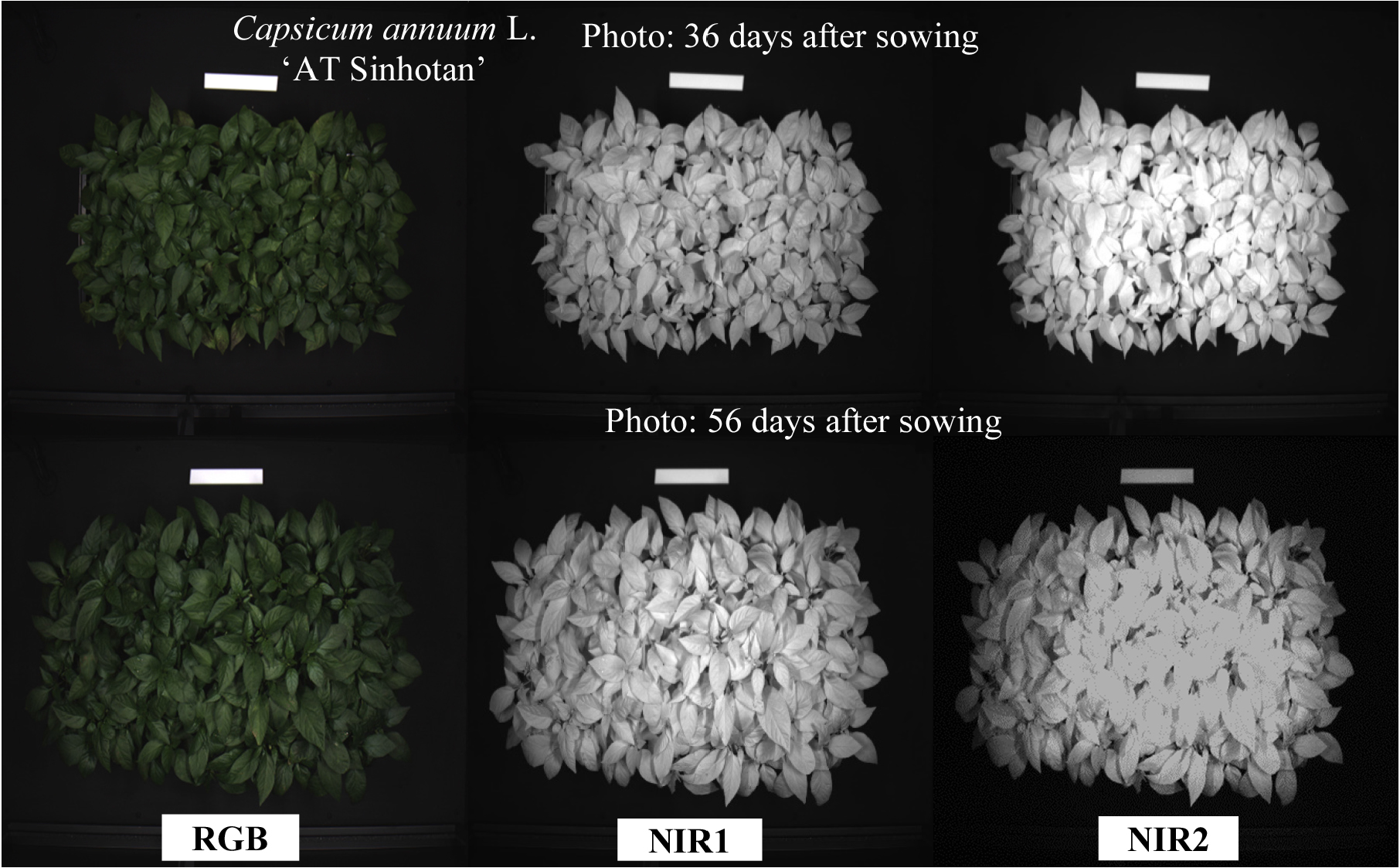
-
Food & Chemistry
- Monitoring soil characteristics of the Saemangeum reclaimed agricultural soils for enhancing upland crop productivity
- Ju-Hyung Shin, Yun-Gu Kang, Jun-Yeong Lee, Jiwon Choi, Ji-Hoon Kim, Jun-Ho Kim, Taek-Keun Oh
- Reclaimed agricultural soils, which accounts for 7.1% (112,464 ha) of Korea’s agricultural land, is increasingly required to support upland crop cultivation amid …
- Reclaimed agricultural soils, which accounts for 7.1% (112,464 ha) of Korea’s agricultural land, is increasingly required to support upland crop cultivation amid national efforts to enhance grain self-sufficiency. However, both low-fertility and high-salinity of these soils significantly hinder crop productivity. This study aimed to assess the physicochemical properties of reclaimed agricultural soils from 69 locations in the Saemangeum reclaimed area to provide foundational documents for improving upland crop productivity. Soil samples were collected in 10 cm increments down to a 70 cm depth and analyzed for bulk density, moisture content, porosity, pH, electrical conductivity (EC), and exchangeable cations (i.e., K+, Ca2+, Mg2+, and Na+) content. The averaged bulk density (1.44 g·cm-3) and porosity (45.76%) at a depth of 0 - 30 cm met the appropriate range for upland crop cultivation, although localized compaction requires attention. Gravimetric and volumetric moisture contents exceeded the optimal standard, ranging from 20 to 25%, suggesting the need for periodic monitoring. Soil pH and EC values increased with the deepening of soil depth but generally remained within sustainable ranges (pH, 6.0 - 7.0; EC, ≤ 2.0 dS·m-1). However, the Saemangeum reclaimed agricultural soils had the excessive K+ and Mg2+ concentrations and insufficient Ca2+ level, which may impair crop productivity. These findings highlight the necessity of targeted soil amelioration strategies, especially Ca2+ supplementation and Na+ mitigation, for sustainable crop cultivation in reclaimed agricultural soils. - COLLAPSE
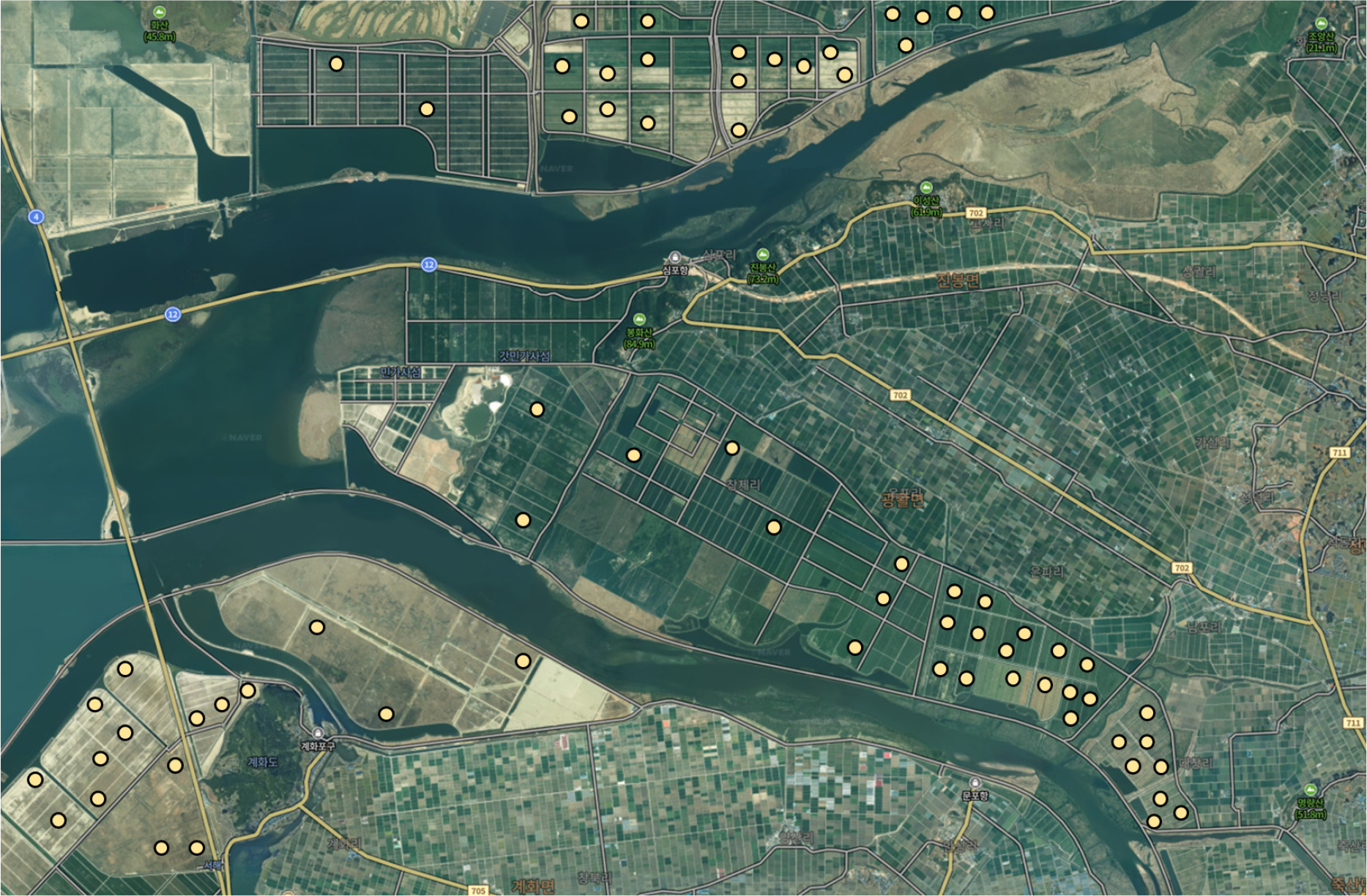
-
Engineering
- Theoretical kinematic analysis of a wheel-driven hopper planting mechanism for vegetable transplanters
- Eliezel Habineza, Emmanuel Bicamumakuba, Md Nasim Reza, Sun-Ok Chung, Soon-Jung Hong
- Vegetable production plays a vital role in the global agricultural economy, and seedling transplanters significantly enhance timely large-scale production, planting efficiency, and …
- Vegetable production plays a vital role in the global agricultural economy, and seedling transplanters significantly enhance timely large-scale production, planting efficiency, and the overall mechanization rate. Due to the limited availability of transplanting machinery, manual transplanting remains the predominant method; however, it is time-consuming, inconsistent, and inefficient. This study presents a theoretical analysis of a customized wheel-driven hopper-type planting mechanism for a vegetable transplanter, focusing on the dimensional design of key components and kinematic parameters, including velocity, acceleration, hopper trajectory, and forward speed required for the smooth placement and deposition of vegetable seedlings. A 3D model of the planting device was designed, and a mathematical model was developed for simulation. The wheel-driven planting mechanism consisted of a wheel, wheel support, roller, roller guide, hopper opener, and hopper. To ensure the synchronization of the vertical and horizontal movements of the hopper, and to achieve consistent and safe deposition of seedlings into the soil, the optimal dimensions of the planting unit were determined as follows: a wheel diameter of 250 mm, a wheel thickness of 6 mm, a hopper opener length of 36 mm, and a hopper height of 80 mm. These dimensions collectively generated an optimal planting trajectory along a circular path measuring 249.9 mm in both the vertical and horizontal directions. An optimal forward speed of 150 mm·s-1 was identified to ensure smooth and upright planting of vegetable seedlings, resulting in a soil contact angle close to 90°, with the planting hopper exhibiting a peak velocity of 131 mm·s-1 and a peak acceleration of 137 mm·s-2 along both the X- and Y-axes. The findings of this study would offer theoretical background to enhance the design of vegetable transplanting mechanisms. - COLLAPSE
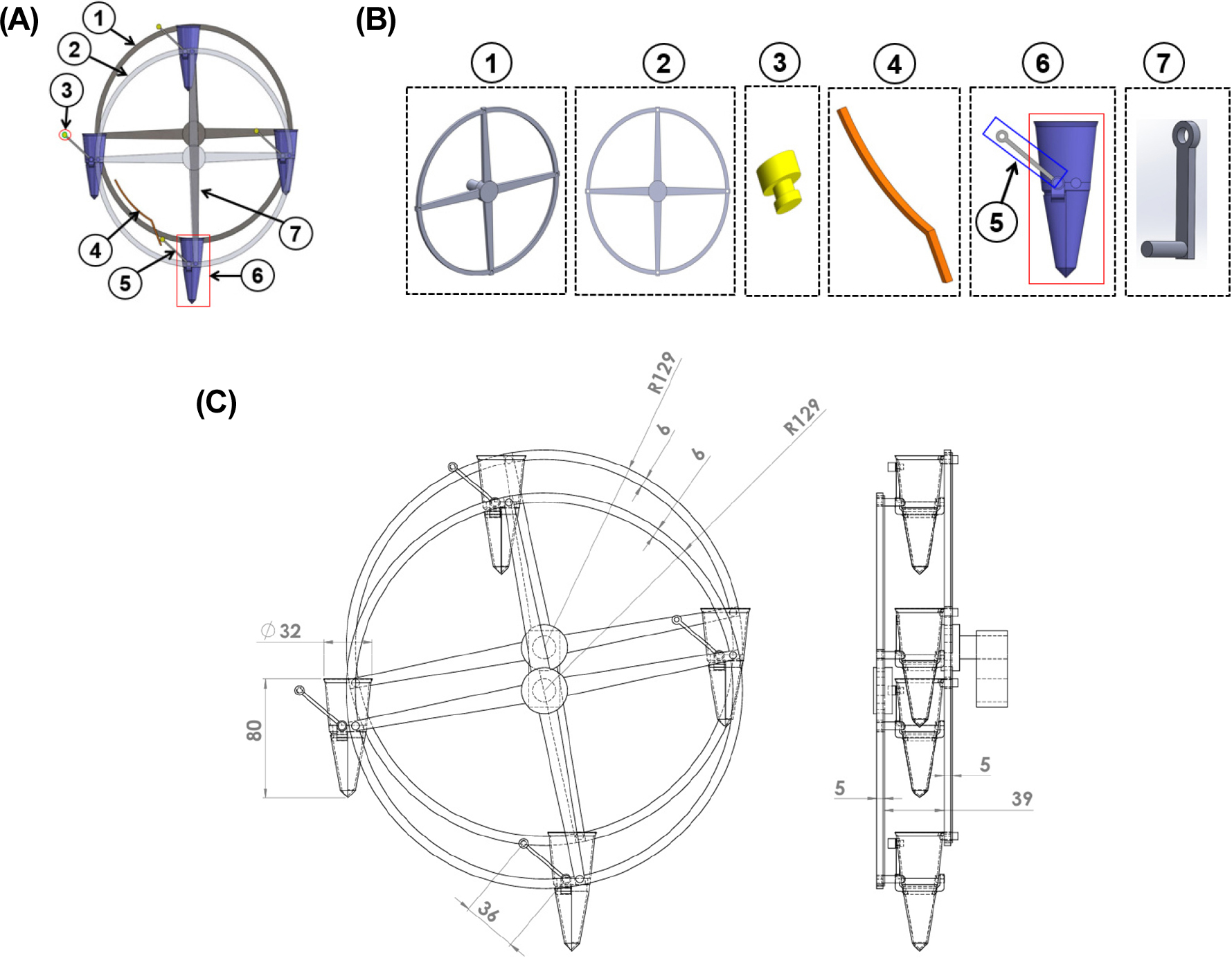
-
Management & Economics
- The impact of Korea’s SPS measures on agricultural and food exports from IPEF member countries: Focused on disaggregated products
- Do Yeon Park, Suk Ho Han, Seungmo Koo
- With South Korea’s participation in the Indo-Pacific Economic Framework (IPEF), there is growing expectation for the country to relax non-tariff barriers, particularly …
- With South Korea’s participation in the Indo-Pacific Economic Framework (IPEF), there is growing expectation for the country to relax non-tariff barriers, particularly sanitary and phytosanitary (SPS) measures. As SPS measures have historically been used to protect South Korea’s agricultural sector, this shift may have notable implications for agri-food imports. This study examines the impact of South Korea’s SPS measures on agri-food exports from IPEF member countries, using disaggregated data classified under HS codes 01-24. Products are grouped into four categories: livestock (HS01-02, 04-05), crops (HS06-14), fisheries (HS03), and processed/other products (HS15-24). Employing a gravity model with panel data, the analysis uses fixed effects model (FEM) and the Poisson pseudo-maximum-likelihood (PPML) estimator to address zero trade flow issues. The results show that South Korea’s SPS measures significantly reduce exports of livestock, crops, and processed products from IPEF countries, while fisheries exports are not significantly affected. By offering a sector-specific analysis based on HS codes, this study provides new insights into the trade effects of SPS measures. Future research is recommended to examine the impact of specific SPS measures at more disaggregated product levels. - COLLAPSE
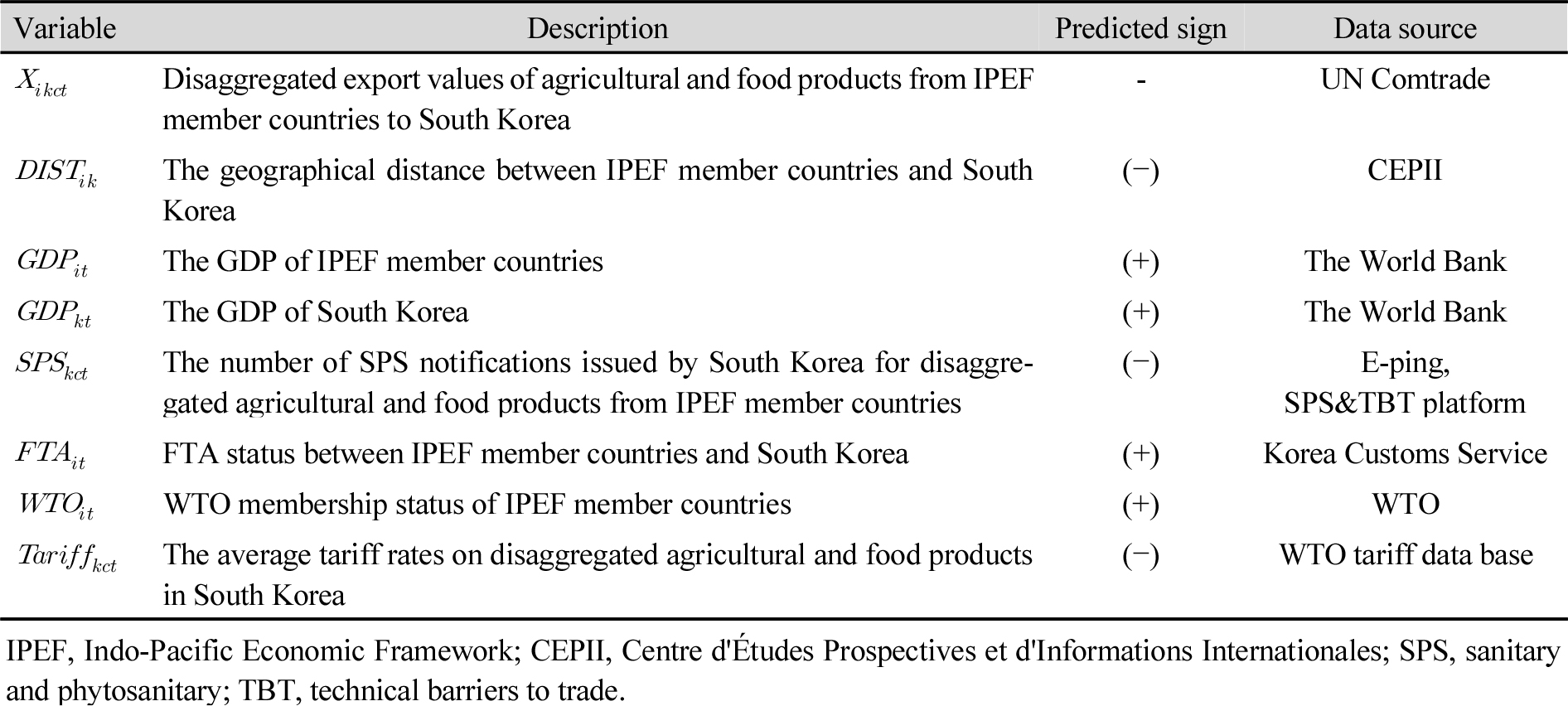
-
Plant & Forest
- Acute toxicity evaluation of herbicide-resistant transgenic chrysanthemum (Chrysanthemum morifolium Ramat.): Effect on Daphnia magna fed with herbicide-resistant transgenic chrysanthemum
- Kyunglyung Baek, Ye Jin Jang, Eun Jung Suh, Doh-Won Yun, Jong-Chan Park, Seong-Kon Lee, Ancheol Chang, Sung-Dug Oh
- Herbicide resistant transgenic chrysanthemum was developed by inserting phosphinothricin acetyltransferase (PAT, bar), a modified gene from the soil bacterium …
- Herbicide resistant transgenic chrysanthemum was developed by inserting phosphinothricin acetyltransferase (PAT, bar), a modified gene from the soil bacterium Streptomyces hygroscopicus, into the genome of a conventional variety of chrysanthemum (Peace copper). Herbicide resistant transgenic chrysanthemum used for the test was confirmed to express the PAT gene by polymerase chain reaction (PCR) and immunostrip. The acute toxicity effect of herbicide-resistant transgenic chrysanthemum and non-genetically modified (non-GM) counterpart chrysanthemum (Chrysanthemum morifolium Ramat.) on Daphnia magna was investigated at different concentrations (0, 50, 100, 200, 500, 1,000, and 2,000 mg·L-1). Feeding tests were conducted with Daphnia magna to evaluate the environmental risk of transgenic chrysanthemum, including herbicide-resistant gene. Daphnia magna was fed 100% ground chrysanthemum suspension, herbicide-resistant chrysanthemum or non-GM chrysanthemum. As a result, the feeding test showed no significant differences in the cumulative immobility or abnormal response between Daphnia magna samples fed on herbicide-resistant chrysanthemum and non-GM chrysanthemum. The 48 h-EC50 (effective concentration 50) values of the non-GM chrysanthemum and herbicide-resistant chrysanthemum were 333.6 mg· L-1 (95% confidence limits: 211.4 - 526.2 mg·L-1) and 348.5 mg·L-1 (95% confidence limits: 228.1 - 532.5 mg·L-1), respectively. The chrysanthemum NOEC (no observed effect concentration) value for Daphnia magna was suggested to be 100 mg·L-1. Based on these results, there was no significant difference in toxicity for non-target organisms (Daphnia magna) between the herbicide-resistant chrysanthemum and non-GM counterparts. - COLLAPSE

-
Animal
- Nutritional values of animal or plant based oil in Beagle dogs
- Seyeon Chang, Hyun-Woo Cho, Won Yong Jung, Han Tae Bang, Kyoung-Min So, Min Young Lee, Sang-Yeob Lee, Woo-Do Lee, Ju Lan Chun
- A balanced diet using various ingredients such as protein, fat, and carbohydrates is important for the health and welfare of companion animals. …
- A balanced diet using various ingredients such as protein, fat, and carbohydrates is important for the health and welfare of companion animals. For this purpose, it is necessary to study the nutritional value of the ingredients of the companion animals’ diets. This study was conducted to investigate the nutritional value of animal- or plant-origin oils as fat sources in companion dogs. Chicken oil and sunflower oil were used as an animal- and plant-origin fat sources, respectively. The dietary treatment groups were as follows: 1) a chicken breast powder-rice based diet with chicken oil; 2) a chicken breast powder-rice based diet with sunflower oil. A total of eight Beagle dogs (4.58 ± 0.14 years old; 4 neutered males and 4 spayed females) were used in this experiment. Palatability, fecal score, digestibility, and blood profile were analyzed and compared to evaluate the nutritional value of animal or plant based oil in dogs. Feed intake was restricted to the maintenance energy requirement of each animal, according to the AAFCO equation. As a result, there were no significant differences (p > 0.05) in palatability, average fecal score, nutrient digestibility (dry matter, crude protein, ether extract, ash, and nitrogen-free extract), and blood profiles according to the feeding of chicken oil or sunflower oil diets. All analyzed blood parameters were found to be within the normal range. In conclusion, this result suggests that both chicken oil and sunflower oil can be used as dietary fat sources without negative effects in dogs. - COLLAPSE
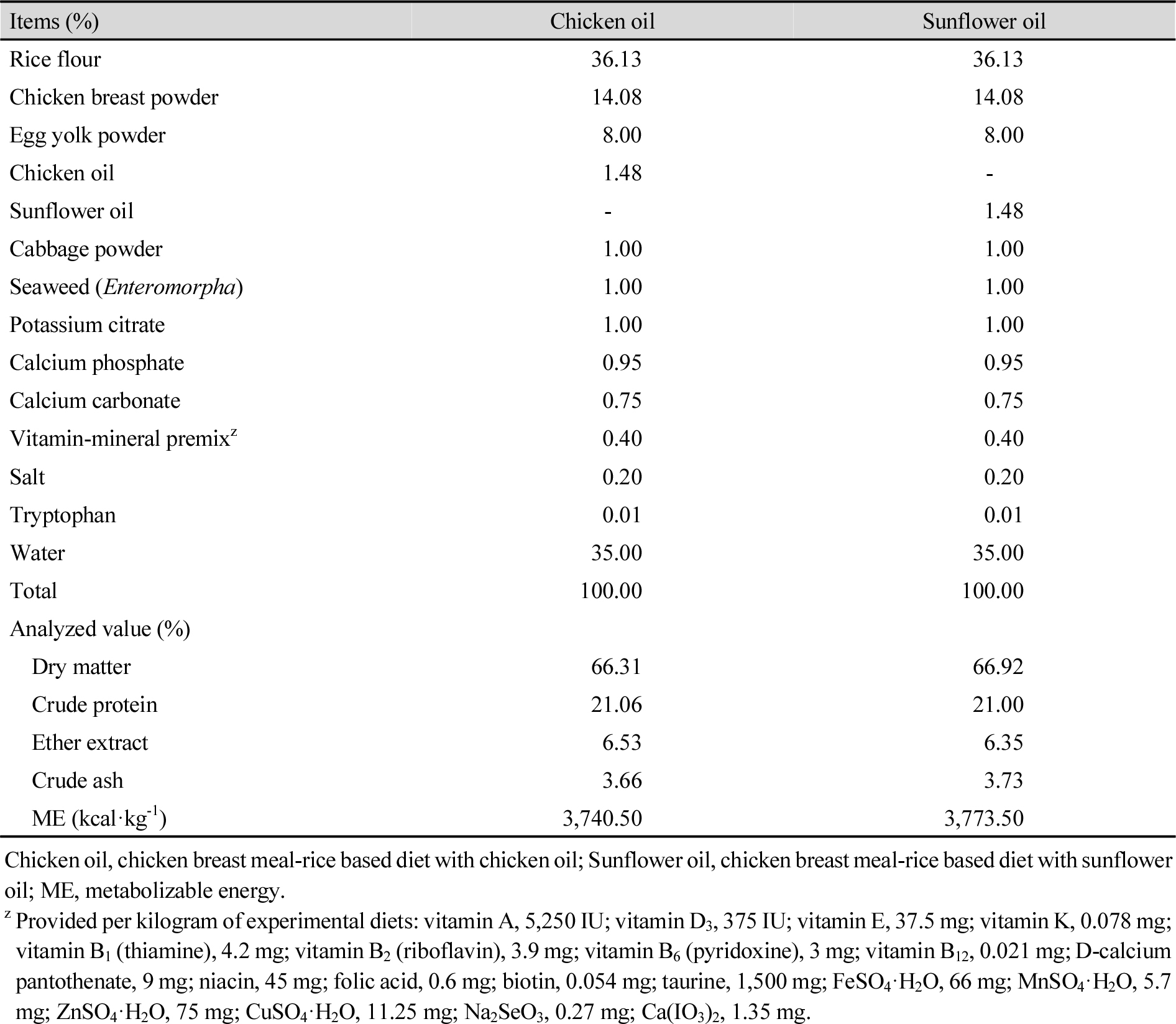
-
Animal
- Genetic analysis and genomic evaluation of marbling fineness in highly marbled Hanwoo steers
- Shil Jin, Hyoun Ju Kim, Jeong Il Won, Sun Sik Jang, Sung-Sik Kang, Sung Woo Kim
- In this study, we evaluated marbling fineness (MF) in Hanwoo steers using the F7 index derived from image analysis and estimated genetic …
- In this study, we evaluated marbling fineness (MF) in Hanwoo steers using the F7 index derived from image analysis and estimated genetic parameters along with four carcass traits: carcass weight (CWT), back fat thickness (BFT), eye muscle area (EMA), and marbling score (MS). Phenotypic and genomic data from 1,156 animals were analyzed using the multi-trait genomic best linear unbiased prediction (GBLUP) model. The heritability of MF was estimated at 0.441, indicating moderate-to-high genetic control. MF exhibited a strong genetic correlation (r = 0.639) with MS, suggesting shared genetic influences between these marbling-related traits. The correlation between MF phenotypes and genomic estimated breeding values (gEBVs) was significant (r = 0.769, p < 0.001), and the mean prediction accuracy based on prediction error variance (PEV) was 0.714—comparable to the accuracies of the four carcass traits. To further improve the genetic gain of MF, expansion of the national reference population, refinement of environmental modeling, and development of more precise genomic prediction methods are recommended. These results highlight the MF’s potential as a novel economic trait in Hanwoo cattle and its value as a selection criterion for future genomic breeding programs aimed at enhancing beef quality. - COLLAPSE
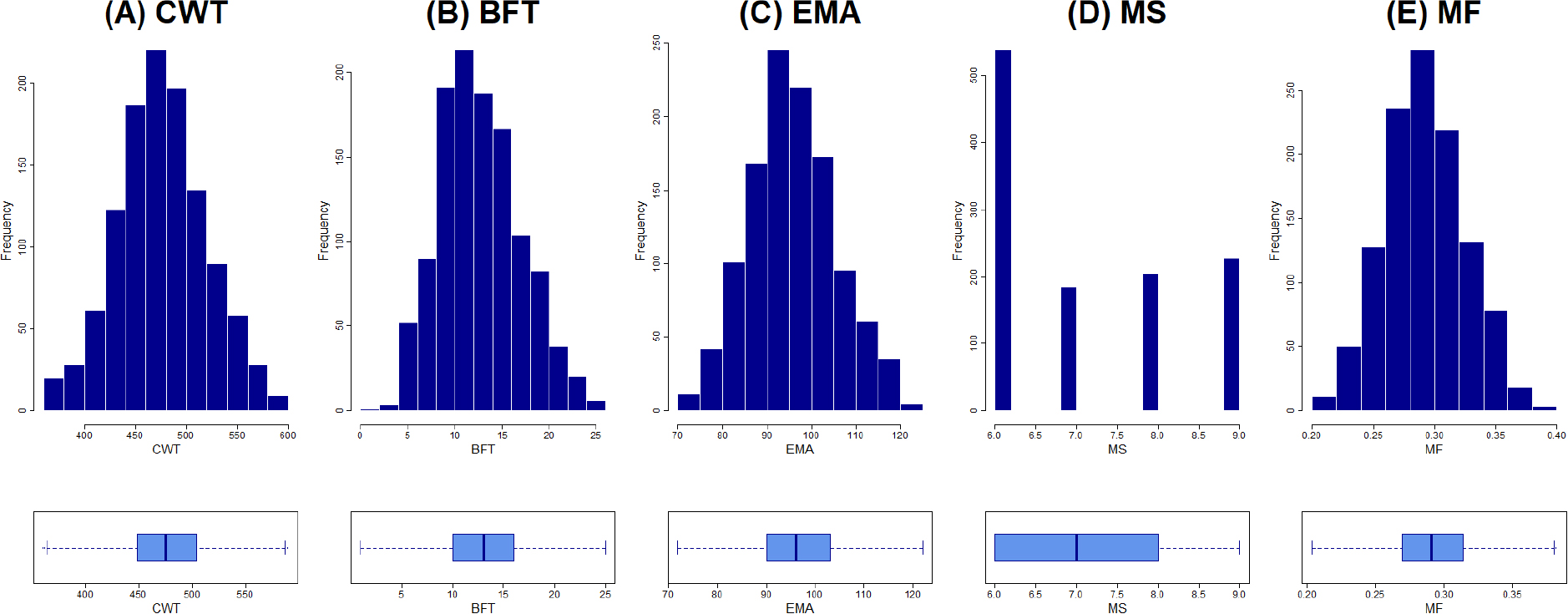
-
Management & Economics
- Consumer preference of quality grading and traceability for poultry products
- Jae Bong Chang, Suk Ho Han
- This study examines consumer preferences for grading and traceability systems in poultry products, specifically chicken and duck, which are currently excluded from …
- This study examines consumer preferences for grading and traceability systems in poultry products, specifically chicken and duck, which are currently excluded from mandatory grading and labeling regulations in South Korea. Using data from a discrete choice experiment, we estimate willingness to pay (WTP) through multinomial and random parameter logit models. Results indicate that consumers assign the highest value to products with both grading and traceability information, followed by those with only grading or only traceability. These findings suggest that consumers place significant importance on transparent and reliable product information, even for poultry. While the estimated WTP may be subject to hypothetical bias, the relative preferences highlight the potential benefits of extending these systems to poultry products. Policy implications include the need for more refined studies to support effective grading and traceability implementation in the poultry sector. Further empirical research and more refined survey designs are necessary to support the development of effective policy and pricing strategies in the poultry sector. - COLLAPSE
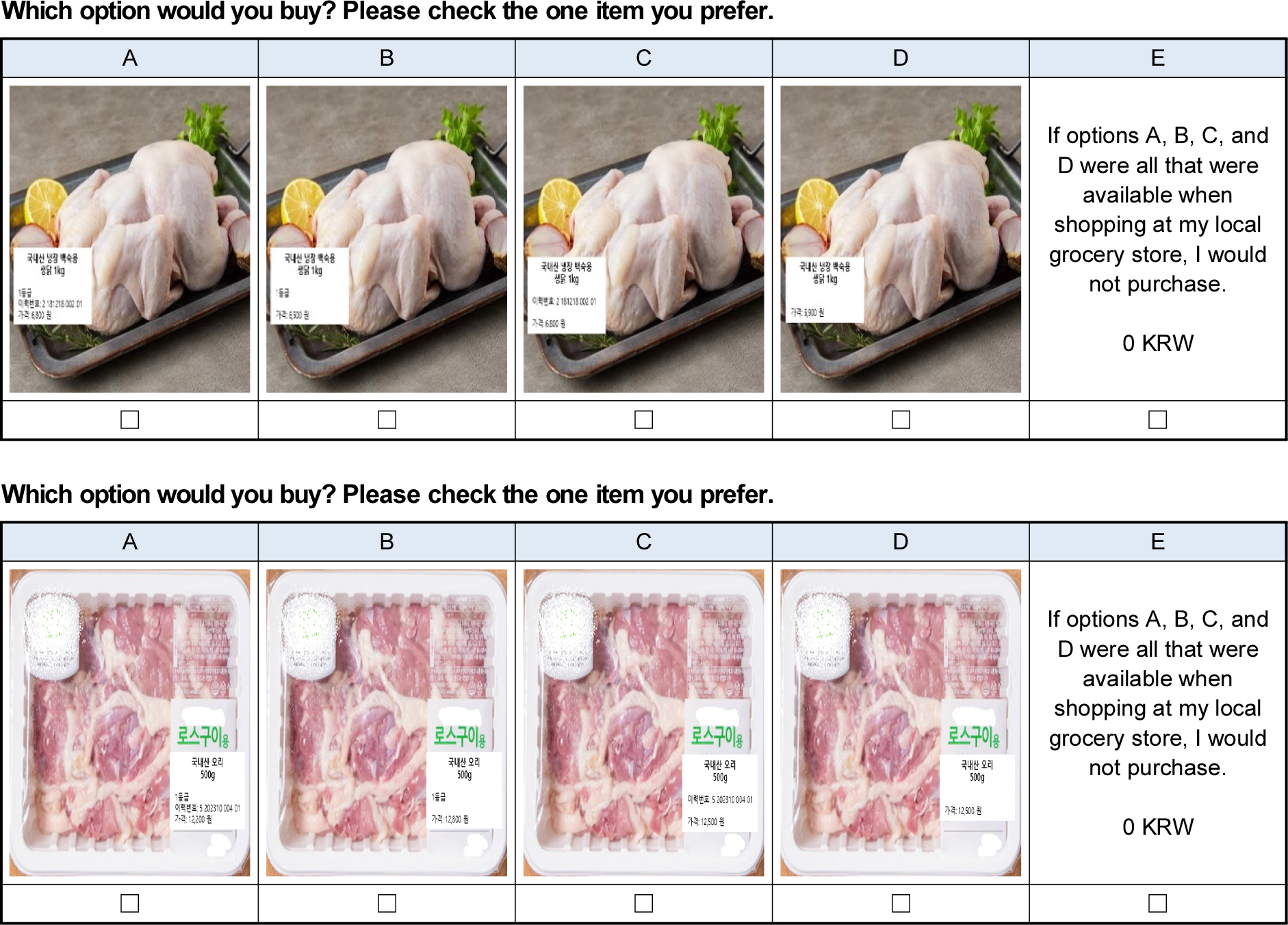
-
Engineering
- Economic analysis of plow-type and conveyor-type sweet potato harvesters: A comparison of purchase and rental methods
- Chan Young Lee, Jeong Hun Kim, Kwang Mo Kim, Ju Seok Nam
- Harvesters used for harvesting operating in Korean sweet potato farms are generally classified into plow-type and conveyor-type. Advantages and disadvantages of each …
- Harvesters used for harvesting operating in Korean sweet potato farms are generally classified into plow-type and conveyor-type. Advantages and disadvantages of each harvester type depending on the operating methods are identified, leading to differences in farm income. Therefore, this study conducted an economic analysis of plow-type and conveyor-type sweet potato harvesters under both purchase and rental methods. For this purpose, work capacity was measured, and cost analysis was conducted for each case of purchasing and renting each harvester. Field experiment was conducted on an actual sweet potato farm to measure work capacity, digging damage rate, and digging loss rate. The work capacity of rental harvesters was assumed to be equivalent to that of purchased ones. Cost analysis was conducted based on the machine cost analysis method proposed by the Kuratorium für Waldarbeit und Forsttechnik e.V. (KWF), which sums hourly fixed and variable costs. Results showed that the plow-type harvester had higher work capacity, whereas the conveyor-type harvester showed superior digging performance in terms of lower digging damage rate. Meanwhile, there was no significant difference in digging loss rate. In terms of cost analysis, the rental method using the conveyor-type harvester resulted in the lowest total cost at 12,950 KRW·10-1·a-1. This is because the plow-type harvester has higher work capacity than the conveyor-type harvester, and the removal of fixed costs such as depreciation and maintenance when using the rental method. Therefore, harvesting operations using a rental plow-type harvester can contribute to reducing the total cost compared to other methods. - COLLAPSE
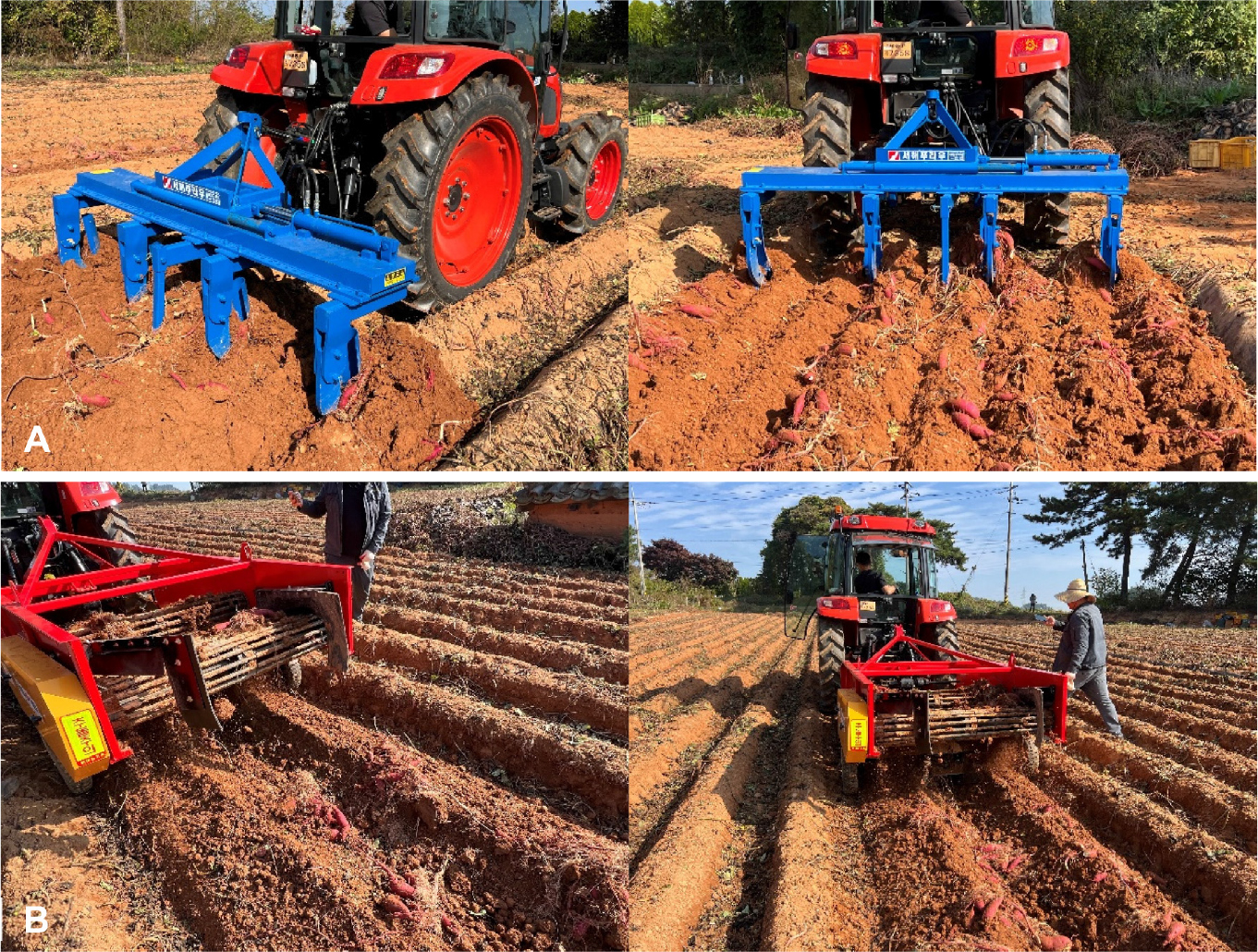
-
Animal
- Monitoring insect fauna in urban forests and comparing insect species diversity with adjacent forests: A case study of the Sejong National Arboretum and Mt. Jeonwol in Sejong
- Jongok Lim, Hojin Jeon, Haneul Yu, Seongil Cho, Jongman Park, Changwoon Lee, Iseul Yun, Seong Yeob Byeon, Keum Seon Jeong
- This study was conducted to monitor the species diversity of insects inhabiting urban forests by comparing the urban forest with adjacent forest …
- This study was conducted to monitor the species diversity of insects inhabiting urban forests by comparing the urban forest with adjacent forest areas, the study aimed to collect baseline data essential for the sustainable development of urban forests. Field surveys were conducted six times from mid-April to mid-October 2024 at the Sejong National Arboretum and Mt. Jeonwol, Sejong. Monitoring results were compared across different survey periods and exhibition gardens. Additionally, an insect fauna survey was conducted in the Forest Garden, one of the exhibition gardens in the Sejong National Arboretum to compare the insect fauna of urban forests and adjacent forested areas, the Mugunghwa Theme Park, located in Mt. Jeonwol. In the insect fauna survey of the 10 exhibition gardens in the Sejong National Arboretum, a total of 12 orders, 80 families in 219 species were identified and the comparison of insect species diversity among the exhibition gardens revealed that the Forest Garden harbored the most diverse species, with a total of 8 orders, 41 families, and 80 species. The results showed that the Forest Garden hosted 8 orders, 41 families, and 80 species, whereas the Mugunghwa Theme Park hosted 9 orders, 61 families, and 128 species. - COLLAPSE
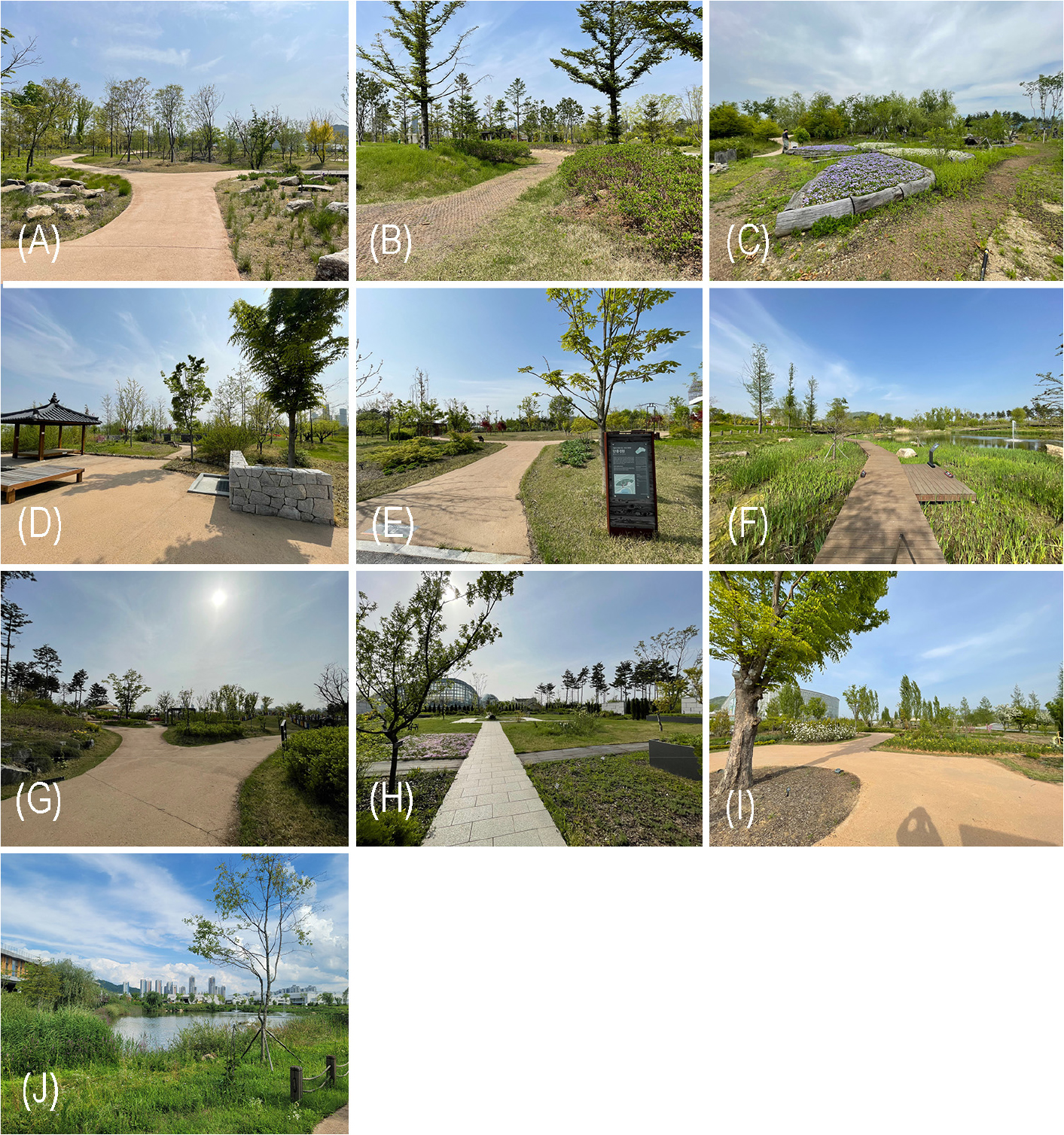
-
Engineering
- Analysis of factors prioritizing extreme weather countermeasures for aged agricultural fill-dams: Through statistical analysis of failure case histories
- Chan Yu, Joon Heo
- Recent extreme weather, especially typhoons and heavy rainfall, has significantly increased the damage to the agricultural aged fill dams. Most agricultural reservoirs …
- Recent extreme weather, especially typhoons and heavy rainfall, has significantly increased the damage to the agricultural aged fill dams. Most agricultural reservoirs are the type of fill dams, and dam failures can cause uncontrollable, catastrophic damage to downstream areas. Therefore, establishing countermeasures to extreme weather events is crucial and urgent social problem. However, long-term forecasting of weather conditions is difficult, and recent extreme rainfall patterns are breaking records, making predicting dam failures even more challenging. Therefore, we analyzed recent failure cases to verify factors that can be identified as highly correlated to the damage of agricultural fill dams. The analysis, based on existing domestic and international research, examined the applicability of these factors using statistical methods, focusing on dam service life, dam height, total water reserve capacity, and the catchment magnification rate. Domestic and international data primarily considered dams service life of 50 years or more, an embankment height of 15 meters or less, and a total water reserve capacity of 200,000 tons or more. We collected a total of 87 cases between 2000 and 2024. As a result of the analysis, dam service life and embankment height showed similar trends to previous research results, suggesting applicability. However, total water reserve capacity showed some differences. Due to the high number of small dams in Korea, the failure rate was high even in small basins, suggesting no correlation between failure cases and the catchment magnification rate. The results presented in this study are expected to serve as important factors in prioritizing reinforcement measures for aged agricultural fill dams in the future. - COLLAPSE
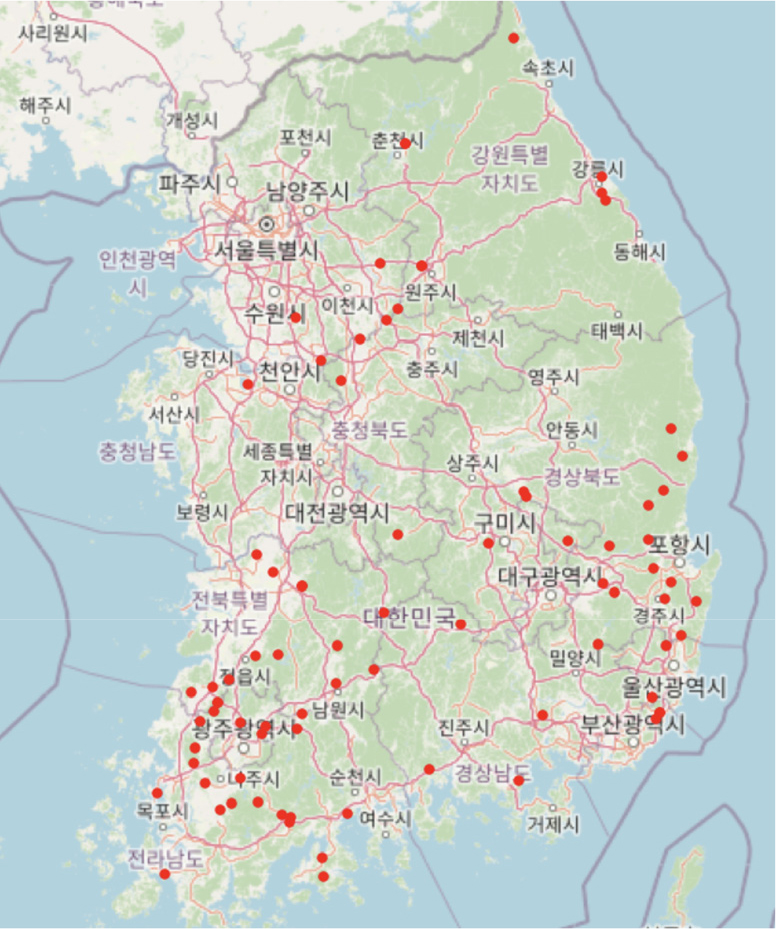
-
Management & Economics
- Structural analysis of the food processing industry
- Gwangsik Oh, Sounghun Kim
- The food processing industry uses agricultural, livestock, and fishery products as raw materials to produce processed foods, serving as a major consumer …
- The food processing industry uses agricultural, livestock, and fishery products as raw materials to produce processed foods, serving as a major consumer of these products and a key contributor to their added value. Since 2008, the Ministry of Agriculture, Food and Rural Affairs has been fostering Korea’s food manufacturing industry, which now has a market size of 83.1 trillion Korean won. The food processing industry is subdivided into various sectors according to product categories, with each sub-sector exhibiting distinct structural characteristics. While certain sub-sectors are marked by a high degree of oligopoly, others are characterized by a competitive market structure involving a large number of firms. Given that the structural differences among sub-sectors of the food processing industry are critical factors in the formulation of relevant policies, it is necessary to conduct research that analyzes these structures and derives policy implications. The purpose of this study is to analyze the structural characteristics of sub-sectors within Korea’s food processing industry and to derive policy implications. Specifically, the study collects data on firm concentration, total sales, and total exports by sub-sector, and examines changes over time as well as interrelationships among key variables. The results derived from the econometric model analysis are as follows. First, the trend analysis of firm concentration across sub-sectors indicates that concentration levels have declined in most sub-sectors, while the overall industry size has increased. This suggests that Korea’s food processing sub-sectors are experiencing growth driven by the entry of new firms. Second, an econometric analysis was conducted to examine the correlation between industry concentration and total industry size (measured by sales). The results show that, in many sub-sectors, concentration levels and industry size tend to move in opposite directions. This provides more concrete evidence supporting the earlier observation. In conclusion, the growth structure of Korea’s food manufacturing sub-sectors can be evaluated as generally positive. This is because a weakening of market concentration reduces social losses associated with the excess profits of monopolistic or oligopolistic firms. Therefore, the government should strengthen policies that promote greater competition within the sub-sectors of the food manufacturing industry. - COLLAPSE
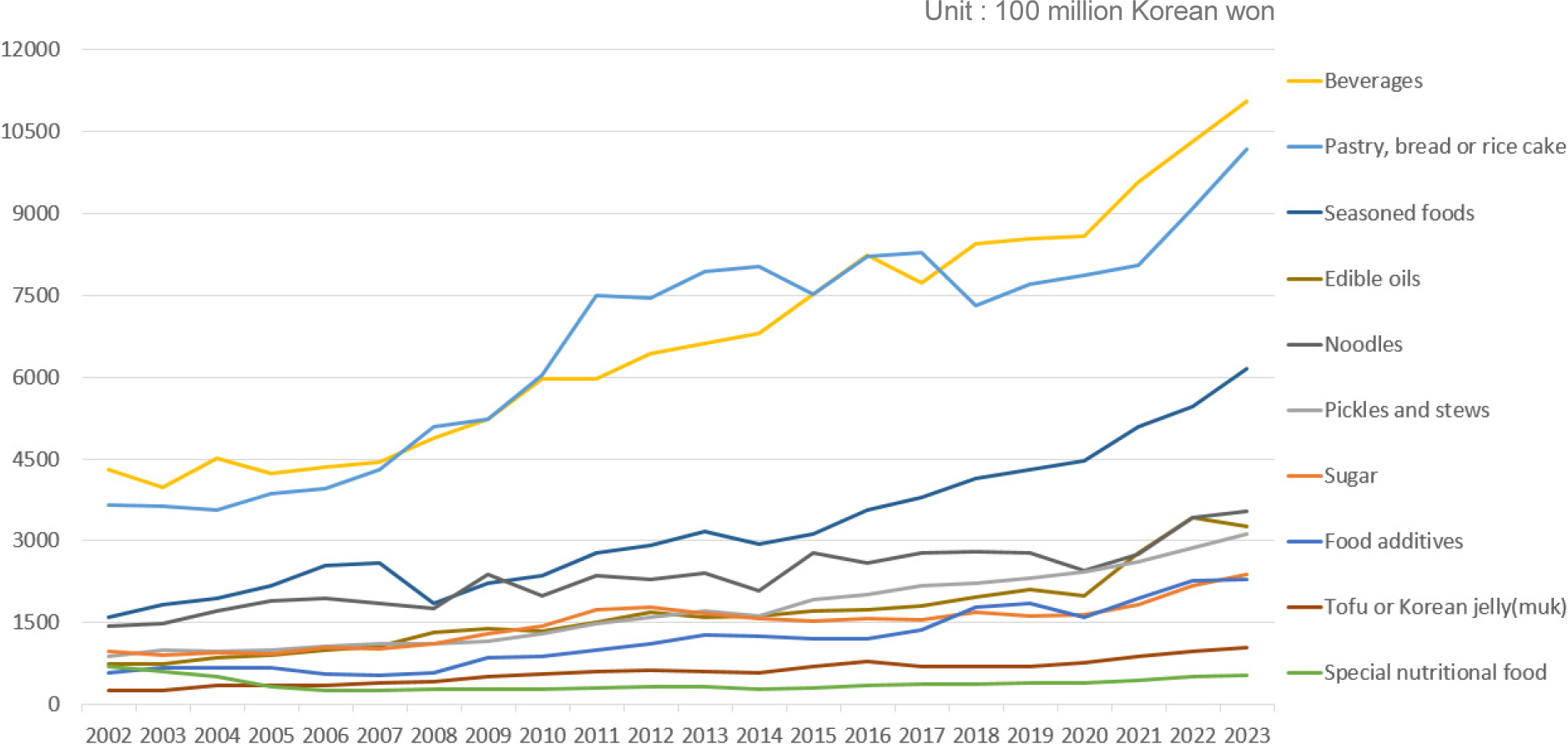
-
Plant & Forest
- Turfgrass quality changes of creeping bentgrass (Agrostis palustris L.) by applying slow-release nitrogen compound fertilizers
- Jeong-Ho Lee, Ji-Hye Kang, Kyung-Mok Lee, Doungyeob Kim, Young-Sun Kim, Geung-Joo Lee
- This study evaluated the effect of applying slow-release nitrogen compound fertilizer on the growth and quality of creeping bentgrass (Agrostis palustris …
- This study evaluated the effect of applying slow-release nitrogen compound fertilizer on the growth and quality of creeping bentgrass (Agrostis palustris L.). The treatments were as follows: no fertilizer (NF), control (straight compound fertilizer for 3 g N·m-2·month-1), slow-releasing methylene urea (MU for 3 g N·m-2·month-1), and slow-releasing isobutylidene diurea (IBDU for 3 g N·m-2·month-1). The soil chemical properties, electrical conductivity (EC), organic matter (OM), total nitrogen (T-N), available phosphate (Av. P2O5), and exchangeable potassium (Ex. K), were increased after applying MU and IBDU. Compared to NF, chlorophyll indexes of MU and IBUD in June were increased by 14.4% and 14.9%, and in September by 20.4% and 17.3%. However, compared with the control, there were no significant differences. Although the average shoot lengths of MU and IBDU were higher than those of NF, they were not significantly different from those of the control. The shoot density and root length of the MU and IBDU treatments were not significantly different from those of the control, inferring that long-term performances need to be further investigated for the detailed effects of the straight or slow-releasing fertilizer following the current season’s evaluation. - COLLAPSE
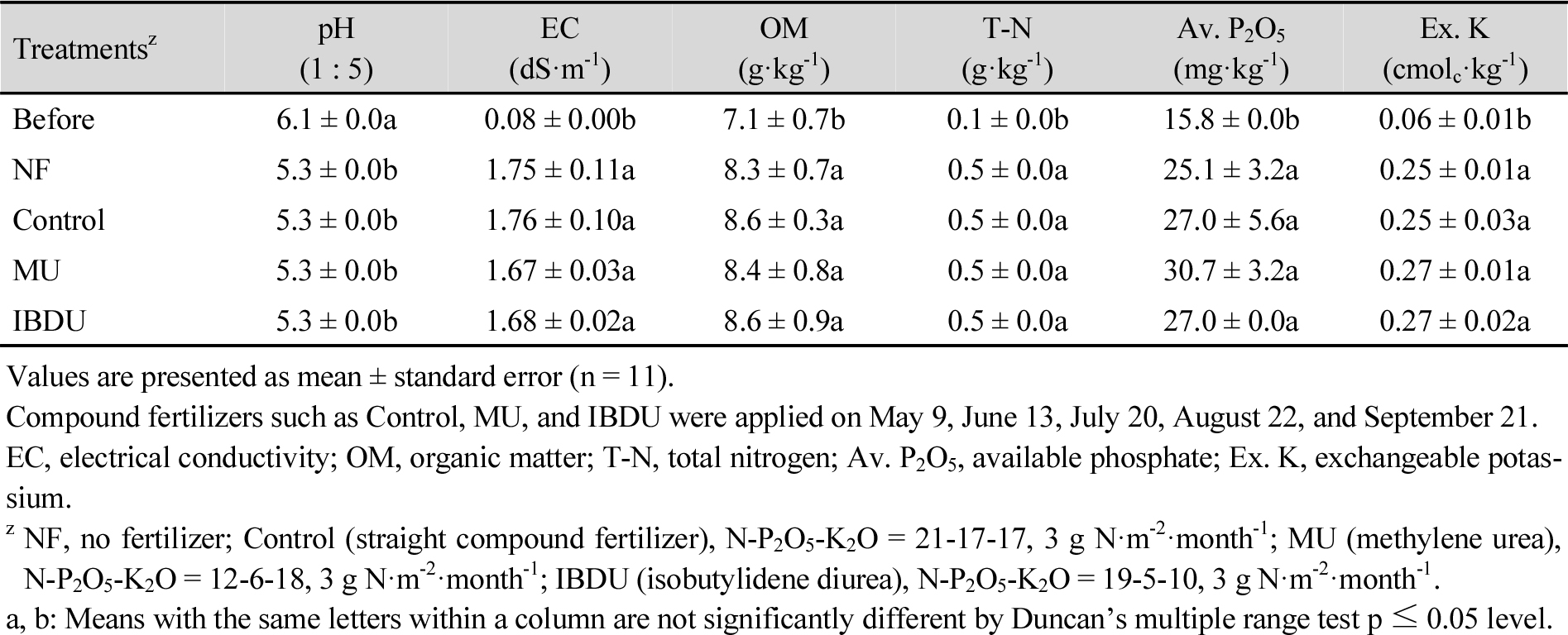
-
Animal
- Effects of reed (Phragmites communis) mixing ratios in cow manure on physicochemical changes and earthworm (Eisenia foetida) survival during composting
- Ji-Hong Lee, Soon Hwangbo
- This study was carried out to explore how adding different levels of reed (Phragmites communis), which is often used as …
- This study was carried out to explore how adding different levels of reed (Phragmites communis), which is often used as roughage and bedding for cattle, would affect the physicochemical properties of cow manure during composting, and how these changes relate to the survival of earthworms (Eisenia foetida). The cow manure and reed were mixed at four different volume ratios: 100 : 0 (CR0), 90 : 10 (CR10), 80 : 20 (CR20), and 70 : 30 (CR30) (cow manure : reed), and the compost was observed over a 6-week composting period. Starting from the third week, earthworms could survive in all treatment groups. The carbon-to-nitrogen (C/N) ratio was significantly higher in reed-mixed groups than in CR0 (p < 0.05), ranging from 23.37 to 32.41 in week 3. The pH and electrical conductivity (EC) tended to be lower when more reed was added, while CR0 showed the highest values. At the point when earthworms began to survive, pH ranged from 7.58 to 7.77, and EC was between 0.95 and 1.15 mS·cm-1. In general, the composting mixtures with reed showed changes in physicochemical conditions that were within the range acceptable for earthworm survival. However, to improve vermicomposting efficiency, further studies seem necessary to evaluate growth and reproduction of earthworms under various reed mixing levels. - COLLAPSE
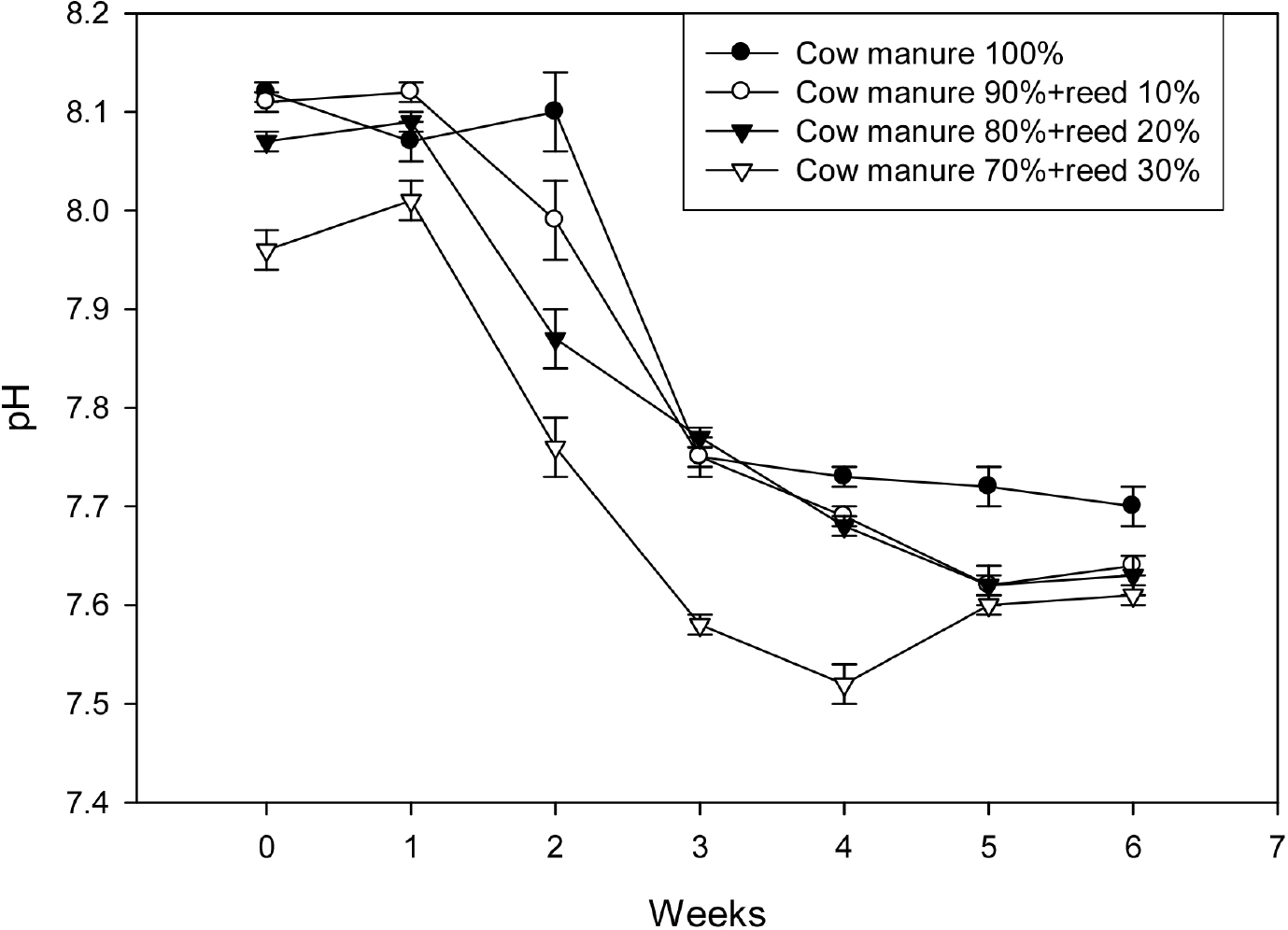
Journal Informaiton
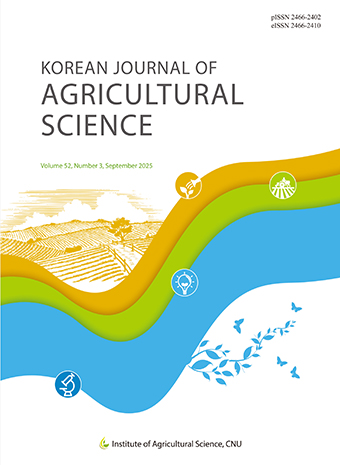 Korean Journal of Agricultural Science
Korean Journal of Agricultural Science
Journal Informaiton
Journal Informaiton - close
 Korean Journal of Agricultural Science
Korean Journal of Agricultural Science



